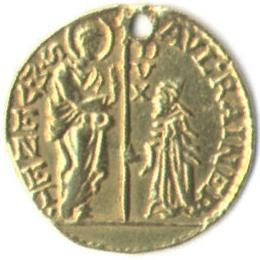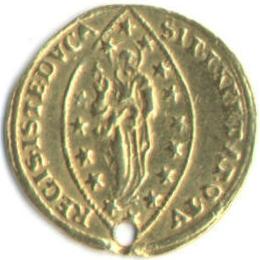| SPECIFICATIONS | |
| Denomination | Ducat |
| Metal XRF | Gold Au.994 |
| Alloy | Ag%Cu 0.81 |
| Type | Struck |
| Diameter | 21.6 mm |
| Thickness | 1.3 mm |
| Weight Legal | 3.494 gms |
| Weight | 3.41 gms |
| Shape | Round |
| Edge | Milled |
| DieAxis | O° |
| Mint | Venice |


|

| 
| ||||||||||||||||||||||||||
| KM #107 Friedberg #1434 | ||||||||||||||||||||||||||||
This AU ducat has been pierced as if to be worn as Jewelry, as was the fate of many of these medieval Byzantium Type coins with Christian religious symbols. The location of the hole appears to indicate the display of the obverse. Also note that the V in the legends is the character U.
It was called a Ducat, the name inscribed on it, but later known as zecchino or sequin. Varying only a little in design it was minted for over 500 years from 1284 till the end of the republic in 1797, The extreme 0.999 purity of the Gold made it a World currency. It was a standard of weight 53.75 grains Troy, or 3.4940 grams with 0.1122 oz of AGW (Actual Gold Weight).
Circulated along side the Netherlands Ducat it was rated in 1701 at Batavia as 18 schellings or 108 heavy stivers. In 1782 when it was put into circulation in Ceylan it was 22 schellings and by 1791 it had risen to 36 schellings of copper money.
Codrington lists the sequins of following Doges during the Dutch Era as been found in Lanka. The last four Doges of the second half of the 18th Century being the most common. The last three are listed in Codrington's 1914 catalog of Coins in the Colombo Museum.
| F1332 | 1659-1674 | Dominico Contarini | DOMIN.CONT | 16 stars 6-point |
| F1372 | 1709-1722 | Giovanni Cornaro | IOAN*CORNEL* | 16 stars 6-point |
| F1379 | 1722-1732 | Alvise Mocenigo III | ALOY*MOCENI. | 16 stars 6-point |
| F1384 | 1732-1735 | Carlo Ruzzini | CAROL.RVZINI. | 14 stars 6-point |
| F1391 | 1735-1741 | Alvis Pisani | ALOY*PISANI* | 16 stars 6-point |
| KM 21 | 1752-1762 | Francesco Loredano | FRANC.LAVRAD* | 16 stars 5-point |
| KM 71 | 1763-1779 | Alvise Mocenigo IV | ALOY.MOCEN. | 16 stars 5-point |
| KM107 | 1779-1789 | Paolo Ranieri | PAVL.RAINER | 16 stars 5-point |
| KM140 | 1789-1797 | Ludovico Manin | LUDOV.MANIN | 16 stars 5-point |
The coin was scanned at 300dpi and displayed at 300dpi. This sequin was not found from circulation in Lanka. It was purchased on ebay from a dealer in Italy in 1999 August. This Ducat is exactly as illustrated in Le Monete Di Venezia by Papadopoli, the definitive publication on coins of Venice.
Various changes in design offer a means of identifying each ducat uniquely. The lettering in the legend and the presence of . or *'s, the character of the Doge's cap, the disposition of the figure of Christ and the nimbus in the oval, the number and arrangement of the stars. The stars with 6-points changed after 1752 to stars with 5-points.
The wane of Ducats from European trade resulted in Indian imitation, with a blundering of legends and interesting transformations. The staff bearing the banner or cross to a staff or tree with trident-like top, the appearance of a lotus in bloom at the feet of figures of Radha and Krishna on the obverse. Ives identifies them as Rama and Sita and their devotee Lakshmana on reverse. The golden age for these imitations was from 1770-1890.
See also Venetian Gold Ducat from 16th century when the Portuguese were in Lanka.
Text edited from
* Ceylon Coins and Currency By H. W. Codrington. Colombo 1924
Page 169 Chapter XIII Miscellaneous - II Venetian
* The Venetian Gold Ducat and its Imitations by Herbert E. Ives,
edited and annotated by Phillip Grierson. ANS 1954.
I thank Benjamin Bell of CNG for his informative E-mail from which I paraphrase above, the drawings from Papadopoli and the copy of Ives & Grierson, a very interesting monograph on these ducats. Ben did his MA dissertation at the University of London on imitations of the Venetian Ducat by studying the collection at the British Museum.